



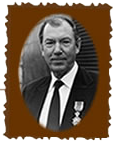
Arild and I are sitting beside a window of the house that he built overlooking the Oslofjord in 1961. Until 3 years ago we would have seen and heard an almost constant stream of planes landing and taking off at nearby Fornebu airport. The airport has now been moved to Gardermoen leaving the sky to seagulls that soar and swoop silently over the glassy water.
The early years
As they did 70 years ago when Arild lived closer to Oslo’s city centre but still only a fifteen minute walk to the fjord with its boyhood delights of swimming, fishing and boating. Frogner was “a fantastic place to grow up in the twenties” he remembers. In winter the ski trails in the wooded hills around Oslo were as easy to get to as was the fjord in summer.
The early years at home were secure and comfortable. Father, a government official, played the violin, mother accompanied on the piano. Sister Helen excelled at her piano lessons – in fact Helen excelled at most things and Arild often felt a bit intimidated when he didn’t reach her high standards.
Still he enjoyed violin lessons until a disagreement with his teacher put an end to his promising career. Perhaps this was the first indication that he preferred to lead rather than follow. Relatives often joined the family for musical evenings and friends were always welcome as were summer visits to their cabins in the Oslofjord. The family idyll shattered when Arild’s father died in 1936 and shortly afterwards the family moved the few kilometres from Frogner to Majorstuen; slightly further from the sea but nearer the ski-slopes.
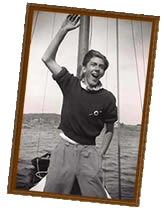 At 15, Arild, now “head of the family”, found to his own surprise that he was fairly practical and adaptable. He could cope with most things. He found school boring however, probably because learning came easy, there didn’t seem to be much competition at school and because his sister, was always so much quicker and brighter than him. He claims that these factors made him lazy; he once borrowed a paper from Helen and submitted it as his own and received a lower mark than his sister.
At 15, Arild, now “head of the family”, found to his own surprise that he was fairly practical and adaptable. He could cope with most things. He found school boring however, probably because learning came easy, there didn’t seem to be much competition at school and because his sister, was always so much quicker and brighter than him. He claims that these factors made him lazy; he once borrowed a paper from Helen and submitted it as his own and received a lower mark than his sister.
Looking back he claims not to have had any special talents and only later realized that he had a marvellous memory. He could read a book and then write out most of it from memory afterwards. No wonder he was bored and no wonder in later life he could lecture and lead meetings without notes.
In retrospect he believes that he worried about family circumstances, about his mother and sister, and that he had an inferiority complex. The first is understandable but inferior is hardly the word we would use in light of his later development. Maybe it was as an active boy scout that he lost this inferiority and discovered his talent for leadership and organisation? Certainly he was greatly influenced by the scoutmaster and as troop leader he became even more familiar with and fond of challenges and the attractions of outdoor life.
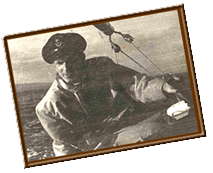 Summer days were mostly spent outdoors on the Oslofjord where kayak and sailboat became the main activities. Winter outdoors, for people who grew up in the west side of Oslo, invokes almost a ‘joint memory.’
Summer days were mostly spent outdoors on the Oslofjord where kayak and sailboat became the main activities. Winter outdoors, for people who grew up in the west side of Oslo, invokes almost a ‘joint memory.’
In the days before two-car families, almost everybody headed for the tram stop at Majorstuen to join the queues that started early. Skis had to be fastened onto the outside of the tram before one could squeeze into a packed compartment for the trip to Frognerseteren, the gateway to Nordmarka. From Frogneseteren the sky, or rather the distant horizon was the limit – 1600 square kilometres crisscrossed with small paths for walking in summer and skiing in winter.
Extreme Sport
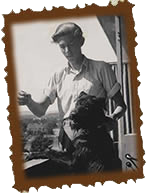 Nordmarka was a playground for Arild and his friends. They never felt better than when on skis – Arild was better than most – but all had the ambition to ski for Norway in a few years. Not content with ‘simply’ skiing, however, these boys practised an early form of ‘extreme’ sport– down ‘impossible’ slopes, ditto on one ski, ditto again in the dark. Today they would have used ski-boards and practised freestyle.
Nordmarka was a playground for Arild and his friends. They never felt better than when on skis – Arild was better than most – but all had the ambition to ski for Norway in a few years. Not content with ‘simply’ skiing, however, these boys practised an early form of ‘extreme’ sport– down ‘impossible’ slopes, ditto on one ski, ditto again in the dark. Today they would have used ski-boards and practised freestyle.
Life wasn’t only sailing and skiing however and as the thirties drew to a close the dark clouds gathering over central Europe began to cast shadows over Norway. At school nothing had changed except that the prospect of university grew clearer and career choices loomed.
Arild thought about being an engineer, or a doctor perhaps? Sister Helen had studied in Germany and was influenced by a pacifist teacher – Arild’s only pre-1940 memory of contact with Norway’s future enemies.
In 1939 Arild had begun studying economics at Oslo University. Today he doesn’t know why he changed his mind about being an engineer or a doctor. Perhaps it was because studying for both these disciplines meant leaving Oslo where his life revolved around family, friends and sports activities – and, of course, the new, almost sinister excitement surrounding the progress of the war.
The war grew in intensity as the new decade dawned but Norway hoped to remain neutral. Everything seemed normal as many Norwegians made their annual Easter trek to the mountains. Arild’s group headed for Hemsedal for long days of cross-country skiing and the more exciting ‘extreme’ challenges away from the well-marked trails. There, one day was one more ‘impossible’ slope. Nobody noticed that the surface snow had melted, making the run truly impossible. One of Arild’s skis smashed into a rock and that was the end of his Easter break. A multiple fractured ankle terminated his ski ambitions and has plagued him ever since. After several operations at a hospital in Oslo he awoke one morning to the drone of aircraft and the thunder of gunfire. It was April 9, 1940.
The attack came as no surprise to a few and a big surprise to most. A daring initiative by the commander of a fort in the Oslofjord sank the German cruiser ‘Blücher’ that carried elite troops whose objective was to capture the King and members of the Government and Parliament. Similar daring political initiative in Oslo organised the escape of all these ‘objectives’ – and they took the gold reserves of the country with them. Thousands of Oslo inhabitants left their homes seeking safety in the countryside, away from the expected bombings and battles. Sections of the disorganised Norwegian military fought heroic battle in central and northern Norway as they awaited assistance from the allies. On June 7th the Royal Family and major government figures escaped by sea to England and after an abortive allied landing at Narvik, the spent Norwegian troops were forced to surrender on June 10th. The German invasion of Norway was over – but their fight for control of the Norwegian people had just begun – and would never be accomplished.
In Norway there had always been a hard core of pro-German sentiment and it was natural that a certain percentage of the population should rally around Quisling’s flag of ‘national socialism’. It was equally natural that, given the independent character of the average Norwegian, the majority would oppose the invaders and their local collaborators. At first the signs of opposition were slight and speculative; wearing a red bonnet, (red for Norway), a paper clip attached to a lapel (we hold together) or a matchstick stuck in a buttonhole (we are ready to strike). Initially the Germans tried the ‘silk glove’ approach but the mailed fist soon appeared when the deep animosity of the men and women in the street, and the growing effectiveness of the small, independent and diversified resistance groups became apparent. These groups were spontaneous and instinctive responses, first to the invasion, and second to the shock and dismay experienced when the Royal Family, Government officials and military commanders escaped to England. Loosely organised and initially with no central organisation the groups showed their resistance through ‘normal’ democratic channels – strikes, petitions and protests. Democracy however, wasn’t a strong card in the Nazi deck and soon it became obvious that any kind of resistance would have to be ‘illegal’ resistance.
On April 10th the hospital had to be evacuated. Arild, with a full-length leg cast, joined his mother and sister at the house of relatives in Slemdal on the outskirts of the city. These relatives, with three children, had, in turn, fled to the safety of the peaceful countryside north of Oslo. On their return two weeks later, Arild remained with this family when his mother and sister returned to Majorstuen. One of his two small cousins remembers this tall, handsome young man: “I was six years old, I sat on his knees as he taught me to tell the time and I was sure I was in love with him”.
Until July, when the cast was finally removed, Arild had much time to think about the future. What would happen, would it be school as usual, what about exams, would there be ‘peace’ or would the allies try to reclaim Norway from the Germans. Tverboven, the new German High Commissioner, though claiming that the Germans would never have broken Norway’s neutrality had it not been for the threats from England, warned that the future of Norway depended upon the attitude of the population.
The attitude of Arild and his friends was quite clear; they would never accept the German occupation. Right from the start they felt that they must show their resistance in one form or another. If only they knew how. The situation was frightening but most of them felt no fear – only excitement. They were at that age where anything was possible, they were invincible – and as the brutal nature of the occupation became clear – full of hate; “We’ll show those devils”. Because of his broken ankle, hospitalisation and convalescence, Arild was unable to join ‘the boys in the woods’ in the fighting that followed the landings on April 9. This made him even more anxious to take part in some form of resistance. His first thoughts, when his ankle began to heal, were to begin training for the struggle that he knew must come. Friends who could trust one another formed a network. Training, exercises and planning began – partly in Vestmarka but mainly at Grimsøen, the summerhouse and scene of so many boyhood adventures.
But this was no boyhood adventure. This was deadly serious and although none of the gang had any military experience, they had a good idea of what had to be done. During the autumn of ’41 and the winter and spring of ’42 they taught themselves hand-to-hand fighting, weapon use (without any real weapons), and strategic thinking. After a while they made contact with London and others in Milorg. (Military Organization). Arild assumed a leading role, obtaining written material and other necessities for their secret training.
This training was as important to them as their studies, and their anti-German ambitions were fuelled by what they could read in the national newspapers:
Illegal Activities
The entire Norwegian press was controlled by the Germans and it was obvious to everyone in the resistance movement that counter-information from the Allies was vitally important. Illegal newspapers flourished and during the summer and autumn of 1941 Arild got the opportunity to participate. A friend of his sister was in contact with ‘somebody’ in the ‘newspaper business’. He asked Arild if he would be willing to distribute illegal newspapers. This was, of course, top secret, and Arild never knew who the contact was. Arild himself should enlist three other reliable friends and in this way the organization would be built up, similar to what we today call a ‘pyramid’. This was perfect for Arild and he said enthusiastically, “yes”. .
With Arild as leader and his friends Claes Berg and Jens Grüner-Hegge as equal partners the group built up a network that distributed a steadily increasing number of illegal newspapers. Their success encouraged them to greater heights – why not start their own news service? In the autumn of 1941 the Germans had confiscated all radios but many ‘normal’ Norwegian families had illegal receivers hidden away in lofts, cellars and outhouses. Getting news from London was comparatively easy.
Their first ’newspaper’ was printed in a loft over the garage behind the house at Parkveien 51 where Grüner-Hegge lived. This was also the place where the link to Jens’ younger brother, Rolf Grüner-Hegge, led to the collapse of the group (more on this later).
To begin with they had only an old, well-used stencil machine that couldn’t handle more than 300 copies. Paper and ink were also difficult to come by. They managed to get these supplied through the organization, but they had to resort to theft to obtain better stencil machines.
The first was stolen from the Ministry of Supply. Later a new, and much better machine,
was ’borrowed’ from an official office situated in Frydenlundsgate, Bislet. Arild says: ”I’ll never forget that cycle trip through Oslo’s streets with a stolen stencil machine balancing on the baggage-rack. We expected to be stopped at any minute”.
The distribution network grew steadily, reaching a peak in the spring of 1942 of several thousand copies. In addition to two weekly newsletters the group printed a fortnightly newspaper ‘Our Land Norway’, with a drawing of the Norwegian flag dominating the front cover. The good connection with ‘the organization’ continued in the form of financial support as well as ink and paper. Arild’s group was not alone: many similar illegal newspapers sought contact with London and assistance from the growing ’organization’.
In early spring 1942, in utmost secrecy, a meeting was arranged in the Gressbanen home of the owner of a printing works. The object of the meeting was to organize an overall control of the illegal newspapers in order to avoid confusion and unnecessary work. All the participants at the meeting wore hoods to protect their identity.
Secrecy and discretion were imperative because the production and distribution of illegal newspapers was an extremely hazardous undertaking. The Germans knew very well that the information in the newspapers helped to uphold the moral and resistance of the Norwegians. Anyone caught producing or distributing illegal newspapers were imprisoned – or worse:
Nationen – Thursday 10 August:
In February ’42 the group moved its activities from Parkveien 51 to a cellar under the church at Ris. The priest was a brother of the printing works owner. The work never ceased to be exciting – would they be able to hide their activities well enough? Not content with the natural threats, copies of each newspaper were sent to the National Police and other suitable opponents – just to irritate!
Another move, this time from the church to Arild’s room at his apartment on the sixth floor at Gardeveien 2C. This was not a good place and they soon got permission to use a cellar under the entrance to the building.
Arild will never forget certain exciting experiences: ”I was on the Holmenkollen tram with a suitcase full of pamphlets on street fighting. German soldiers and Norwegian sympathisers were all around me. I felt sure that the suitcase looked suspicious and I expected that at any minute I would have to make a run for it. But all went well…”
In Hiding
But not all went well. Jens and his younger brother Rolf shared a room. It was almost impossible to avoid Rolf finding out that big brother Jens was involved in some form of illegal activity. Rolf himself had come in contact with a network of distributors. He, and three other 16 year olds, thought it exciting to fool and challenge the Germans and their Norwegian co-operators. The youngsters knew that they were treading on dangerous ground but just didn’t realize all the implications of their activities until one of them made a mistake – and then everything went wrong.
0145 May 7 1942
Rolf Grüner-Hegge was sleeping but awoke when the light in the room was switched on. His father’s voice said: ” It’s the police, they want to speak to you son” ”Where did you get the illegal newspapers” asked a strange man who bent over the bad. “I don’t know anything about newspapers”, replied Rolf.
At first, Jens thought that the police were after him and he could hardly believe his eyes when he saw that his brother was their prey – a younger brother he didn’t see again until after the war. In spite of his youth, Rolf was imprisoned and brutally tortured by the Gestapo.
Rolf’s arrest made Arild, Jens and Claes afraid for their own activities. They went into hiding but continued their illegal work. Shortly afterwards, however, Claes and Jens were arrested and Arild knew that it was only a question of time before he would be next.
Claes and Jens sat in their separate cells and felt certain that Arild had made his escape to Sweden. But Arild hadn’t left. “No, I thought running was the easy way out, there were many loose ends after our illegal activities – loose ends that should be obliterated.” The first stop was at Claes’ home to get a radio, not only to avoid it being discovered if the house was raided but because Arild needed a radio. All the equipment in the crypt under Ris church was moved to Arild’s home at Gardeveien 2c where his mother had lived alone since Arild had gone underground.
Two new friends had joined Arild after Rolf and Claes were arrested and the printing continued in the cellar at Gardeveien 2c. The new group built up a larger and more professional distribution network. ”Yes, it was challenging to take chances and to fool the Gestapo and their Norwegian stooges, it was tonic both for the spirit and body” said Arild, and adds: ”but I was careful – every time I had to visit Gardeveien I telephoned first to hear if the coast was clear.”
Escape
The Gestapo, however, couldn’t be fooled all the time. One day, just after Arild had spoken to his mother, the telephone rang again and Mrs Walder heard “a hoarse voice” ask to speak to Arild. She replied that he wasn’t there and she didn’t know where he was. But the voice continued – ”you must put me in contact with him, I’m one of his colleagues, this is a matter of life and death. Where can I meet him? You must help me.”
Mrs Walder was convinced. ”He’s coming here soon and I’ll tell him you called”.
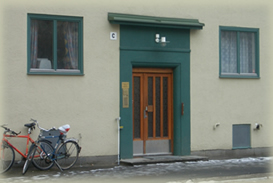 Shortly afterwards, Arild unsuspectingly put his cycle outside the entrance to Stairway C i Gardeveien 2 and took the lift up the sixth floor. As he opened the door of the lift a man jumped in front of him pointing a pistol. The man told Arild that he was under arrest and ordered him to go quietly down the steps with his hands up. The man spoke in broken Norwegian. On the fifth floor Arild was told to stop and the man began to put handcuffs on him. Arild protested saying that he would go quietly and would rather avoid all the neighbours seeing him led away in handcuffs.
Shortly afterwards, Arild unsuspectingly put his cycle outside the entrance to Stairway C i Gardeveien 2 and took the lift up the sixth floor. As he opened the door of the lift a man jumped in front of him pointing a pistol. The man told Arild that he was under arrest and ordered him to go quietly down the steps with his hands up. The man spoke in broken Norwegian. On the fifth floor Arild was told to stop and the man began to put handcuffs on him. Arild protested saying that he would go quietly and would rather avoid all the neighbours seeing him led away in handcuffs.
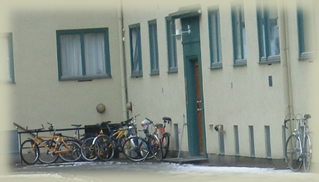 He tried to act naive, as though he didn’t quite realize the seriousness of the situation, and why he had been arrested. The man put the handcuffs away and they continued down the stairs.
He tried to act naive, as though he didn’t quite realize the seriousness of the situation, and why he had been arrested. The man put the handcuffs away and they continued down the stairs.
Arild figured that the man, one of the low Gestapo thugs, was as scared as he was. He also thought it probable that the pistol’s safety catch was on because the worst thing that could happen was that the man had to return to his superior and report that Arild had been killed.
If this happened, there would be no further unravelling of the resistance network. ’He has a partner” thought Arild. They often worked in pairs and probably there was a car close by, parked so that it didn’t invite suspicion or warn the prey. The man pushed Arild through the entrance to the building.
As they rounded the corner, Arild noticed a group of people at the end of the block. “Here and now” thought Arild, who whipped around and swung his fist as hard as he could.
The man was smaller than Arild so the punch caught him on the top of his head, knocking him to the floor where he fell against a sharp corner. There was no sign of the gun and Arild had no time to look for it. He ran towards the corner where he had seen the people standing, thinking that the man wouldn’t shoot in that direction. From here it was 15 meters to the next corner and Arild was running for his life. Around the next corner Arild heard the first shot and a bullet whistled by. Either the man he had knocked down, or his partner, was after him. Whoever was chasing him had the choice of stopping to take careful aim or of running and shooting wild. It seemed that he chose the second course. After each shot Arild saw a spurt of cement dust on the entrance wall in front of him. From here to the next entrance was 70 meters with no cover. ”If only I could reach my cycle” thought Arild. He was probably running faster than he could have cycled, but by now he was almost exhausted. Another pursuer appeared as Arild ducked into the neighbouring stairway and ran up to the third floor. He rang the bell on the nearest door.
A small, elderly lady opened up but the sight of Arild scared her and she tried to close the door again. He pushed by her, stormed through the apartment and out onto the balcony. From here he strode over to the neighbouring balcony, and so on, pushing aside plants and shades, till he came to an apartment in his own Stairway C. He banged on the balcony door. Another startled lady let him in, he raced to the window on the other side of the room, looked out and saw one of his pursuers waiting below.
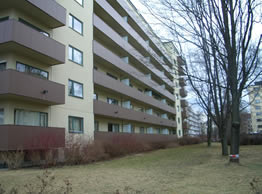 He spun around and rushed back the way he had come; from balcony to balcony back to the lady he had terrified in the first apartment, back through the apartment, out the door and down the stairs. By the entrance stood one of his pursuers. Back up the stairs again, rang both bells on the doors on the first floor. The one that opened first was to the apartment at the end of the block. He threw himself inside, went through the door to the balcony, swung himself over the railing and dropped down the two meters onto the pavement. He sprinted along the path that he had so unsuspectingly cycled along in what seemed like only an instant ago.
He spun around and rushed back the way he had come; from balcony to balcony back to the lady he had terrified in the first apartment, back through the apartment, out the door and down the stairs. By the entrance stood one of his pursuers. Back up the stairs again, rang both bells on the doors on the first floor. The one that opened first was to the apartment at the end of the block. He threw himself inside, went through the door to the balcony, swung himself over the railing and dropped down the two meters onto the pavement. He sprinted along the path that he had so unsuspectingly cycled along in what seemed like only an instant ago.
From behind he heard ”Stop thief, stop thief” – he was being chased again – but now on open streets – down toward the tram sheds at Majorstuen. He slipped into an open door at one end of the long building, sneaked between the silent trams, came out of a door at the other end, and hopped over a low fence. He felt that his heart would burst as he ran down Slemdalsveien. Luckily, outside a chemist shop, he found an unlocked bicycle and in no time was peddling full pelt down Kirkeveien.
”They’ll follow me in a car” he thought as he thanked his lucky stars that he knew this neighbourhood better than most. Munthesgate was a narrow street leading into Kirkeveien just before the main entrance to the Vigeland Sculpture Park – a street that he knew was closed to traffic by an old iron barrier. If he reached this street they would not be able to follow him. He swung into Munthesgate, speeded down the narrow street and at last felt he was almost out of danger.
He knew there was a ‘safe house’ at the corner of Rådhusgaten and Øvre Slottsgate and fifteen minutes later he burst into the office, collapsed on a chair and heaved with exhaustion, unable to say a word for several minutes. A bullet had ripped open one side of his jacket but he had not noticed it during the chase. He was unharmed and he was safe. The date was June 19, 1942.
Experienced friends and colleagues took care of him. First they dyed his hair blond. Then, equipped with glasses and new clothes he was so changed that his own sister didn’t recognize him in the street a few days later.
In another ’safe house’, at a family in Nobelsgate, he lay low until identity papers and a travel pass for the Elverum area were forged. One day in the beginning of July 1942, Kaare Steen, alias Arild Walder crossed the border into Sweden.*
At this time, the local law enforcement officials in Sweden were more pro-German than pro-Norwegian and they questioned all who crossed the border. They were most interested in knowing the route taken by the ‘fugitives’ and who had helped them. Naturally no Norwegian would answer such questions but not all were imprisoned as Arild was when he got to Karlstad. It was 10 days before the Norwegian Embassy got him out – after they had received a report from the resistance movement in Norway. ”It was a happy day.” Arild Remembers.
* The section from ‘In Hiding’ is taken from the book ‘Gestapo henter deg om natten’ by Rolf Grüner-Hegge. The book is recommended for all who are especially interested in the Nazi resistance by young people.
Sweden
Ever since the German invasion of Norway, a regular stream of Norwegians had been crossing the border into neutral Sweden. Many of them were wanted by the Gestapo for ’illegal’ activities in Norway, others belonged to minority groups, afraid for their lives under the German-controlled regime. Most of the young escapees were anxious to continue their journeys to a place where they could fight against the Germans. But first they had to spend some time in a transit camp. Arild immediately tried to get over to England but to no avail. Finally he made his way to a Norwegian enclave in Uppsala where he could, at least, continue his studies in Social Economics that he had started in Oslo University the previous autumn.
At that time his studies, and those of his friends, were interrupted by the illegal resistance work. Now his almost constant efforts to get out of Sweden didn’t allow much time for studying either. None of his efforts was successful and almost in desperation he even tried to get help from the Russian Embassy.
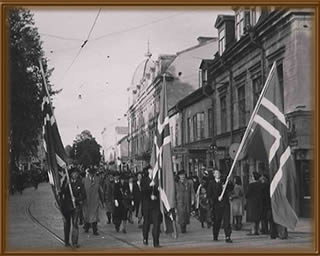
17 May in Sweden
Autumn went by and Arild saw the prospect of a frustrating Christmas in exile. His 21st birthday was on December 29 and on that date a notice in ’Aftenposten’ proclaimed that Arild Walder had forfeited his Norwegian citizenship “because of traitorous activities”. It is hardly necessary to ad that there was absolutely no problem in reinstating his citizenship in 1945.
The loss of his citizenship didn’t bother him but during the winter his health declined and early the following year his doctor diagnosed pleurisy.
Arild didn’t take this too seriously and after a short stay in hospital he insisted that he was well enough to be discharged. Three weeks later he was back – and this time there was no doubt about the seriousness of his illness.
After a while he was transferred to a sanatorium at Örnsköldsvik, where he was compelled to do no more than rest and relax. By now he was practically resigned to his fate when an unexpected letter arrived from the Norwegian Embassy. His school records and recommendations from the ‘organisation’ had finally brought results: he had been chosen for ”transfer” – to Canada for pilot training. His doctors were not sure that he was fit enough, he was still convalescing, and had to take it easy. But Arild was adamant and on his own responsibility he went to Stockholm to report for duty. “Unfortunately I didn’t pass the physical. Finally realizing how ill I really had been made a deep impression on me. Now, at best I was in convalescence.”
All hopes of combat were dashed and Arild concentrated on local affairs. The war drew to a close and finally it was over – what a fantastic experience! All that remained now was to bring things back to normal. The Norwegian students in Sweden were set to work and Arild became a guide for the many Norwegians who were anxious to get home to Norway. He travelled with them, checked their papers and assisted these involuntary expatriates – many of whom were disoriented and confused. These trips kept Arild busy during May and June and then it was his turn to return to friends and family in Norway.
Peace – and back to studying
In the autumn of ’45 he took the first section, Social Economy at the University of Oslo and completed his studies in ’48 with a good laud in the final examination. A sojourn in London at the London School of Economics could not hope to compensate for his lack of participation in the final years of the war but the experience at the LSA gave him valuable intellectual and academic insight.
Right after graduation, Arild began to work at the Næringsøkonomisk Forskningsinstitutt (Business Economics Research Institute). His main task was to analyse current politics and to make suggestions for alternative solutions. The results of this work were published in a series of pamphlets. It was an exciting and interesting project. After 5 years at the NF he was engaged (head-hunted we would call it today) as permanent secretary for Joakim Lemkuhl, and responsible for reports on conditions in Norway. He was also engaged in tax questions especially with reference to the process of changing company accounts in connection with the reorganisation from private to publicly held companies.
When Managing Director Kaare Petersen i Den Norske Bankforening (The Association of Norwegian Banks) was looking for a secretary/advisor, the choice fell on Arild. His activities here, lectures, analysis, statistics and research were right up his street. Street that led to major changes in Arild’s future career.
One of the research projects concerned the problems encountered by the banks when considering long-term/fixed credit for their clients. The retail banks were primarily concerned with and organised for short-term credit. Arild’s idea was that the retail banks should co-operate and give guarantees that would replace mortgage security in the obligation market. From this came the idea of providing an instrument for handling these loans. The concept was presented to the Treasury Department that approved the plan. At the same time they demanded that the proposed company should also be responsible for the long-term export credit that competition in the capital goods market had made absolutely necessary. The result was Forretningsbankenes Finansierings- og Eksportkredittinstitutt, later shortened to Eksportfinans(Export Finance).
Export Finance
Arild remembers those early days: ”We started with just me and a secretary. They were turbulent times because not everyone agreed that a new financial institution was necessary. Although the major Norwegian banks were the original backers, they still needed to be convinced that Export Finance’s function and ambitions would be supplements rather than competition to their own activities. I didn’t imagine then that this new creation would be the dominating factor for the remainder of my business life.”
Most Norwegian banks became shareholders at the outset and it was the banks well-oiled organisation, their client relations, knowledge of documentation and control that made it possible for Export Finance to operate and maintain a sleek and effective organisation.
The rules and conditions governing International Banking were not always the same from country to country. Most governments subsidised capital goods manufacturers. These subsidies were often financial loans and it was not always possible to compare the various conditions. It was tempting for many countries to extend the official support and thus give their own exporters a relative advantage. The increasing chain reaction of unrestricted credit competition was of grave concern. In 1978 these worries led the OECD to ’Consensus’ – an understanding among members that official support to export credit should be restricted.
Export Finance maintained excellent relations with the Government that, parallel with the OECD’S guidelines, formalised their plans and decisions in Parliamentary Agreement 108. This act was an important factor in Export Finance’s solid foundation.
The implementation of 108 signalled a new phase for Export Finance. The company had already assisted the authorities in several important cases and now it was given the task of administering the new subsidy system. One OECD publication described Export Finance as a private company with an official character – an extremely accurate observation. The 1978 agreement for Export Finance to administer the official subsidy system was renewed in 1999.
It was obvious to Arild that if Export Finance were to become a viable tool for Norwegian exporters the company had to do more than provide suitable credit facilities. Therefore, from an early stage, the company began accumulating market information and developing contacts to stimulate business and to facilitate agreements.
This new market competence was especially valuable in the Eastern European countries, in Russia and in China – states where the economy was centralized and dominated by Governments. Export Finance’s agreements with these countries were foresighted and became more and more important to Norwegian exporters as time went by.
Agreements were also made with large importers in South America and with several African countries. All these activities bolstered and finally established the company’s image as an expert advisor to Norwegian exporters on all phases of trade. The consequent growth increased the stature of the company abroad and strengthened its position in the international loan market.
Export Finance was also involved in the struggle to secure favourable financing in Norway for Norwegian capital goods in competition with foreign suppliers. In cooperation with Storebrand as guarantor, a relatively simple system was established to automatically provide long-term financing at competitive rates. This was especially important for industries such as Aluminium, Oil, Shipbuilding and the new North Sea oil installations.
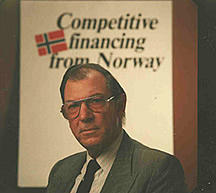 It is not practical to go into details of all activities but the ones mentioned indicate the wealth of ideas and the ability to recognise and adjust to the major challenges facing the realisation of the company’s vision.
It is not practical to go into details of all activities but the ones mentioned indicate the wealth of ideas and the ability to recognise and adjust to the major challenges facing the realisation of the company’s vision.
By the end of the seventies, Export Finance had the financial strength, the commercial know-how and the international prestige that was necessary to secure relatively inexpensive loans from the capital market abroad.
Because of its size and stability, the American market was second in importance after Europe. But to obtain competitive conditions in America it was necessary to obtain a credit rating from special rating institutions.
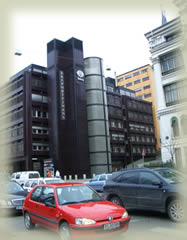 Two of these institutions, Moody’s and Standard and Poor’s, gave Export Finance their ’Triple A’ rating in 1980. ’Triple A’ is the highest credit rating that can be obtained in America and Export Finance was one of the few financial institutions outside the USA to have earned this accolade. As if to celebrate, Export Finance moved for the fifth time. But now the building they moved into, close to the centre of Oslo, was their own.
Two of these institutions, Moody’s and Standard and Poor’s, gave Export Finance their ’Triple A’ rating in 1980. ’Triple A’ is the highest credit rating that can be obtained in America and Export Finance was one of the few financial institutions outside the USA to have earned this accolade. As if to celebrate, Export Finance moved for the fifth time. But now the building they moved into, close to the centre of Oslo, was their own.
By the time Export Finance celebrated its 25th anniversary it had become the largest private financial business in Norway. The staff had grown to 100 men and women – the same number employed today. A pleasant and interesting environment and a highly qualified staff were the foundation for the recurrent good company results.
And good results were necessary because Export Finance’s special concept, in its endeavour to obtain the highest possible credit rating, could not afford to accept business losses. In this aim the company was successful thanks to decisions based on solid theory and a painstaking accuracy in all phases of the business. Every year, the company was able to report that no losses had been sustained on the loan portfolio. This was one of the most important factors in maintaining the company’s prestige in the international loan market.
Arild’s final year as Managing Director illustrates this strength: from zero to 26 billion kroner in as many years and not one single year without a profit. Small wonder that Jan Einar Greve, Chairman of the Council of Representatives, wrote in the Annual Report for 1988:
”Arild Walder has led the development of the Company since 1962 when, as secretary for a Bank Association working party he formulated the basic concept of Export Finance; ‘To utilise the long-term capital markets for the advantage of Norwegian exporters of capital goods, services and ships’. … This has been Arild Walder’s brainchild. He and his colleagues have demonstrated great skill in building up Export Finance to be a key centre of competence linking the authorities and the business community. … Special mention must be made of the system, which was built up in 1977/78 in collaboration with the Ministry of Finance to allow officially supported export credits for capital goods. … Trust is a prerequisite for cooperation of this kind, and Arild Walder has performed the central role in establishing and nurturing this atmosphere of trust. …On behalf of all those who have held office in Export Finance in the course of the last 26 years I would like to thank Arild Walder for his outstanding contribution, and not least for the pleasure it has been working with him and getting to know him as a person.”
Other Tasks
The challenges of Export Finance took most of Arild’s time – but not all. In the beginning he maintained his academic connections and after a number of years censoring examination results he was appointed professor at the University in Oslo. His task was to lecture 4 hours weekly to law students.
“The lecture room was always full so my lectures, given without the aid of notes, must have been interesting” says Arild.
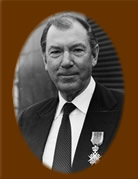 In 1970 he was appointed Chairman for the National Tourist Council, a group whose objective was to find a new approach and business/political understanding of ’tourism’. One of the main findings of this group was the concept of ’course and conference’ activity for hotels – a concept that had major positive consequences for the hotel industry.
In 1970 he was appointed Chairman for the National Tourist Council, a group whose objective was to find a new approach and business/political understanding of ’tourism’. One of the main findings of this group was the concept of ’course and conference’ activity for hotels – a concept that had major positive consequences for the hotel industry.
He was a member of several official committees, a board member of the Norwegian Export Council for six years and wrote numerous economic and mercantile articles and reports.
In 1984 Arild Walder was appointed ”Knight (1st class) of the Royal Norwegian Order of St Olav” for his long and important contribution to Norwegian commerce and for his activities during the war.
”Firm Foundations”
When Arild reached retirement age in 1988 and vacated the top job in Export Finance, the magazine ’Economic Revue’ wrote that Export Finance was a business with firm foundations that got top marks in an international evaluation and that the only way to maintain the company’s influence in the international capital market was to continue with the system employed during the past 25 years. Fifteen years later the financial results for 2003 confirmed this opinion; another year with substantial profit and a large increase in working capital.
But wasn’t Export Finance just another finance business, a kind of super bank established at the right time and the right place, one might ask? We let dr.philos, Arvid Flagestad, previously employed in Export Finance, answer for us in a letter written to Aftenposten in 1991:
”…He (Arild Walder) was the strategist and operative leader of a financial institution which, in these critical days, is one of the largest and most prestigious of its kind in Northern Europe. The growth of Export Finance was a result of close and trustful cooperation between the authorities on one side and the owners on the other. Export Finance established the basic framework that provided a fertile environment for growth and strength. However, Export Finance’s success was by no means a foregone conclusion. The basic conditions and the operating strategy were both created with impressive originality and vision. These attributes made Export Finance an institution that attracted international attention both for its structural strength and for its pronounced service attitude towards Norwegian exporters. The fact that Export Finance became a partner with authorities in their foreign business policies was of special interest.
The man behind the ideas and the force in their creation is Arild Walder… a leader whose prestige was tops both before and after his retirement.”
There were many other paeans to Arild upon his retirement – from the authorities, banks and businesses. “I was obviously lucky”, says Arild, “when I think back over the many interesting but turbulent years in Export Finance.
Full Time Retirement
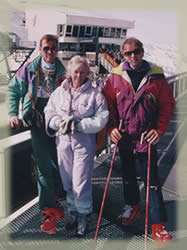
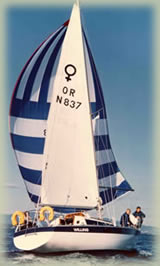 After a few years as a special advisor to Export Finance, Arild went into full time retirement. Challenges awaited at the house and garden by the fjord at Holtekilen. The summer house at Lillesand and the cabin in the mountains at Høvringen gave ample opportunities for fantasy, leisure and activities, so retirement was no time for laziness
After a few years as a special advisor to Export Finance, Arild went into full time retirement. Challenges awaited at the house and garden by the fjord at Holtekilen. The summer house at Lillesand and the cabin in the mountains at Høvringen gave ample opportunities for fantasy, leisure and activities, so retirement was no time for laziness
As a neighbour to Fornebu, with the resultant noise problem, it was natural for Arild to become engaged in the fight to get the airport moved. And when the ‘planes stopped flying in and out of Fornebu the change around the Oslofjord was enormous.
From being almost unlivable the area once again became interesting – practically a paradise. Arild was elected to the local community board that worked to maintain standards and improve conditions. As Chairman of the Holtekilen User and Landowners Association he led the fight for beach-owners’ rights: not only their land interests but for optimal maritime utilization.
Yes, Arild Walder has every reason to rest on his laurels and enjoy the knowledge that his efforts have been successful, for his business, for himself and for his family. His wife of 50 years and two fine sons have been of invaluable support.
Until a few years ago Arild continued his boyhood interests of sailing and slalom. One of his sons lives next door while the other commutes between New Mexico and Northern Norway. Both are ’entrepreneurs’ like their father and both share their parents’ love of the open-air and their childhood home beside the now quiet and peaceful Oslofjord.
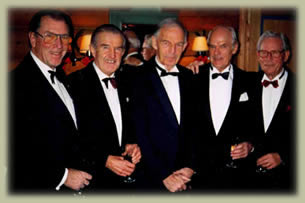
Arild, Claes, Knut J, Gunerius, Knut P
Else and Geoff Ward, Asker 2004/5